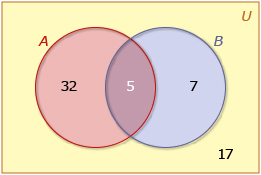Lesson 2
1. Lesson 2
1.7. Explore 3
Module 2: Probability
In Discover, you compared the probability that Janek would move on his next turn using two sets of rules. You now know that the rules in Game A were mutually exclusive and the rules in Game B were non-mutually exclusive. Did you notice that the probability calculation was different?
Read “Example 1” on page 167 of your textbook to see how the mutually exclusive formula is developed. The formula is summarized as follows:
P(A or B) = P(A) + P(B)
P(A ∪ B) = P(A) + P(B)
How might this formula be different for non-mutually exclusive events? Read “Example 2” on pages 168 and 169 of your textbook to see a probability calculation of events that are non-mutually exclusive. Remember that the elements in the union must be subtracted from the sum of the elements in each set when developing the probability formula for non-mutually exclusive events. The formula is summarized as follows:
P(A or B) = P(A) + P(B) − P(A and B)
P(A ∪ B) = P(A) + P(B) − P(A ∩ B)
Note: The non-mutually exclusive formula can also be used for mutually exclusive events because P(A and B) will be zero.
Self-Check 2
- A card is randomly selected from a standard deck of playing cards. To the nearest hundredth, determine the probability of a
- Graphic organizers are a good way to represent mutually exclusive and non-mutually exclusive events. Use the Venn diagram to answer the questions that follow.

![]()
- Complete question 5 on page 177 of your textbook. Answer
- Complete questions 1.c. and 1.d. on page 176 of your textbook. Answer
- The integers from 1 to 12 inclusive are written on 12 separate slips of paper and placed in a hat. One slip is drawn at random from the hat. Rounded to the nearest hundredth, find the probability that the number is a